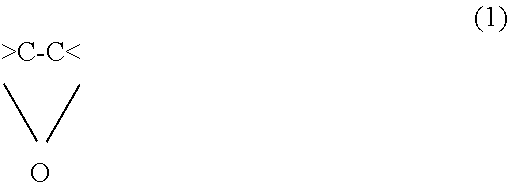Radiation curable resin composition and rapid three-dimensional imaging process using the same
a technology of curable resins and compositions, applied in the field of radioactive curable resins, can solve the problems of generality, not yet fully cured and therefore subject to postcuring, part distortion, and excessive color development of resins
- Summary
- Abstract
- Description
- Claims
- Application Information
AI Technical Summary
Benefits of technology
Problems solved by technology
Method used
Image
Examples
specific embodiments
[0177]The instant claimed invention will now be described with respect to several embodiments. The specific ingredients mentioned in these embodiments are described in detail in Table 1, below.
[0178]
TABLE 1Material NameMaterial DescriptionVendorCyracure UVR-61053,4-Epoxy Cyclohexyl Methyl-3,4-Epoxy CyclohexylDow ChemicalCarboxylateUVR 6128Bis((3,4-epoxycyclohexyl)methyl)adipateDow ChemicalEbecryl 3605Partially acrylated Bisphenol-A epoxy resinCytecEpon 825Bisphenol A Diglycidyl Ether Epoxy ResinHexionEpon 828Bisphenol A Diglycidyl Ether Epoxy ResinHexionEpikote 806Bisphenol F Diglycidyl EtherJapan Epoxy Resins Co.Epalloy 5000Diglycidyl ether of Hydrogenated Bisphenol-ACVC ChemicalEpikote 834Hi MW Bisphenol A Diglycidyl EtherJapan Epoxy Resins Co.OXT 1013-Ethyl-3-hydroxymethyl-oxetaneToagoseiOXT 221Bis{([1-ethyl(3-oxetanyl)]methyl)etherToagoseiOXT 2123-Ethyl-3-[(2-ethylhexyloxy)methyl]oxetaneToagoseiDCE 4107-Oxabicyclo[4.1.0]heptane 3-carboxylic acid, 2-ethylhexylDixie ChemicalesterS...
examples
Preparation of Dispersions
[0211]Core-shell powders are added to epoxy resin with gentle stirring and mixed until the powders are wetted. The slurry is transferred to the mix can of a three-shaft Versamixer manufactured by Charles Ross & Sons. The slurry is mixed at 60 rpm with the anchor mixer, while the water jacket is heated with hot water. When the slurry temperature reaches 35° C., the disperser speed is set to 5000 rpm and the water flow to the water jacket is stopped. When the slurry temperature rises to 45° C., the disperser speed is raised to 6500 rpm and the emulsifier speed is set at 5500 rpm. The mix can is evacuated to a vacuum of 948 mbar once the temperature reaches 60° C. When the temperature reaches 80-82° C., the disperser and emulsifier are turned off and the mixture is cooled by flowing cold water through the water-jacket. Once the temperature falls below 50° C., the anchor agitator is turned off and air is re-admitted to the mix can. Alternatively, dispersions ca...
PUM
| Property | Measurement | Unit |
|---|---|---|
| wt % | aaaaa | aaaaa |
| wt % | aaaaa | aaaaa |
| wt % | aaaaa | aaaaa |
Abstract
Description
Claims
Application Information
 Login to View More
Login to View More - R&D
- Intellectual Property
- Life Sciences
- Materials
- Tech Scout
- Unparalleled Data Quality
- Higher Quality Content
- 60% Fewer Hallucinations
Browse by: Latest US Patents, China's latest patents, Technical Efficacy Thesaurus, Application Domain, Technology Topic, Popular Technical Reports.
© 2025 PatSnap. All rights reserved.Legal|Privacy policy|Modern Slavery Act Transparency Statement|Sitemap|About US| Contact US: help@patsnap.com



